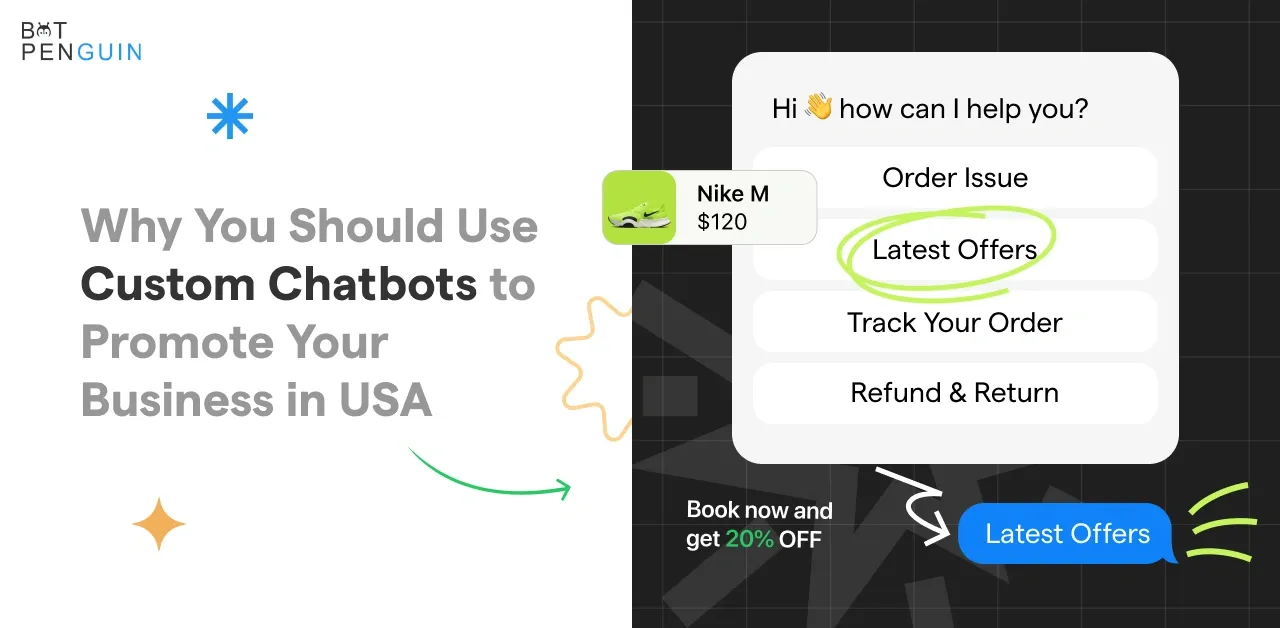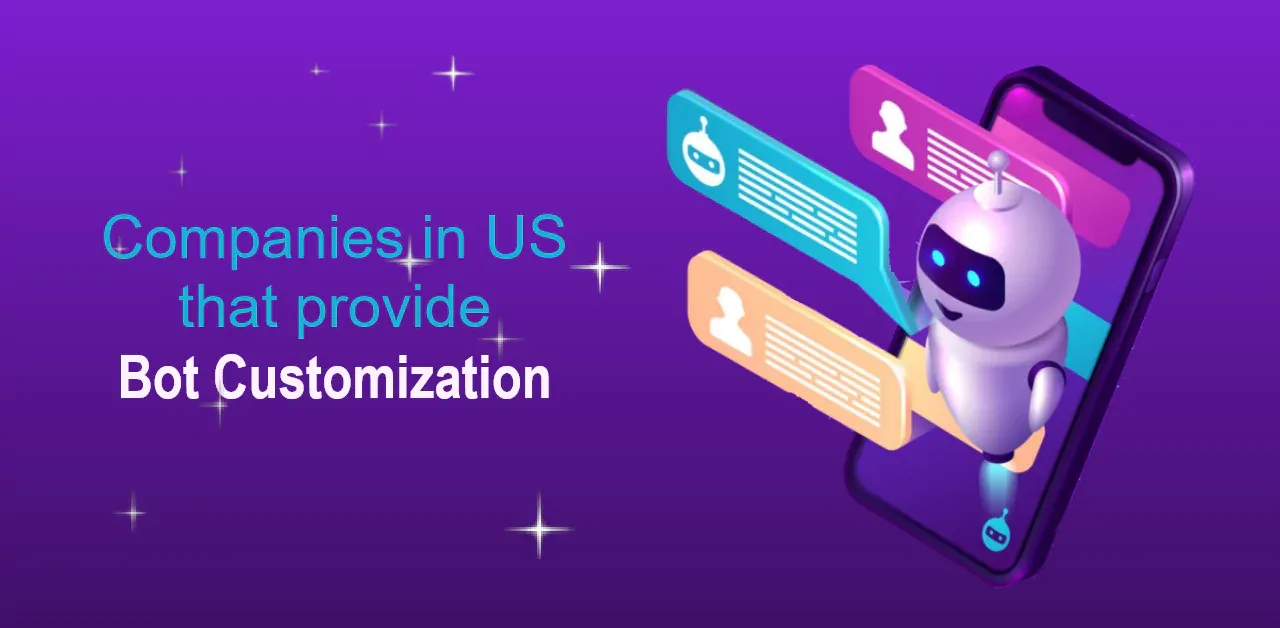Have you ever wondered how voicebots contribute to making technology more inclusive?
With an estimated 4.2 billion voice assistants expected to be in use by 2024, the world is witnessing a massive shift toward conversational interfaces (source: Juniper Research).
In today's modern era, voicebots are gradually breaking down barriers and empowering people of all abilities to interact with technology more seamlessly.
In this blog, we'll explore the top 10 voicebots that are leading this revolution and enabling a more inclusive experience for users worldwide. So grab a seat, and let's dive into the fascinating world of voicebots!
What is a Voice Bot?
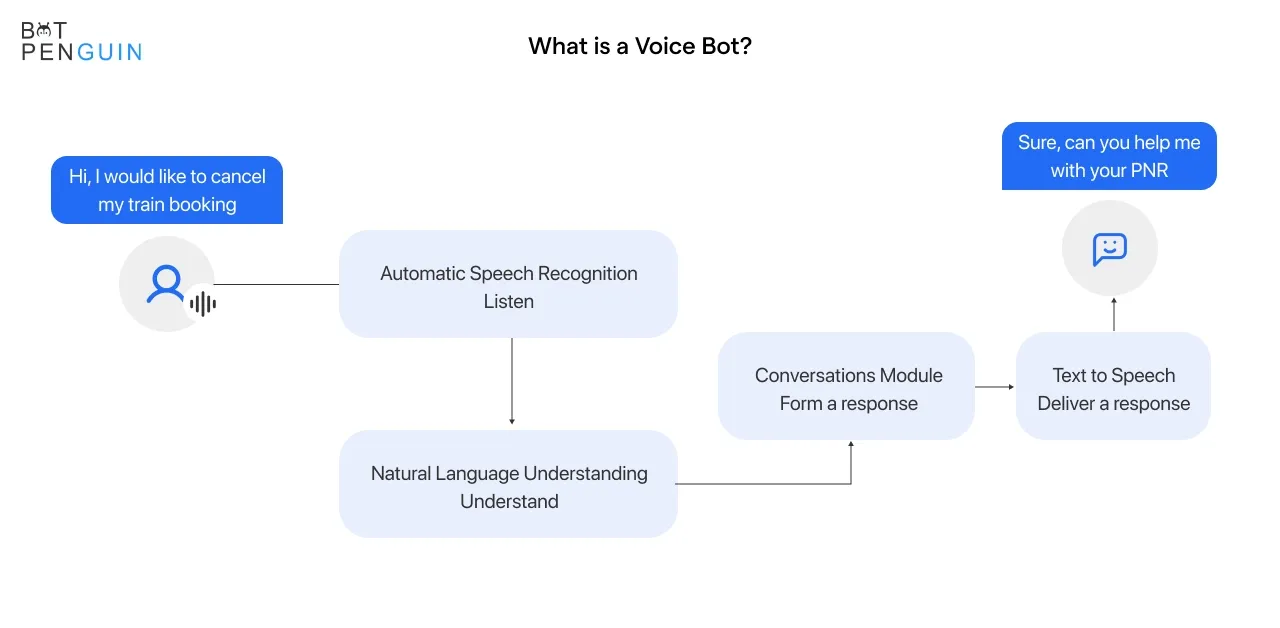
Voicebots, or voice chatbots, are AI-based programs with machine-learning algorithms that respond to speech instructions. Voicebots use natural language generation (NLG) and natural language processing (NLP) to hear and respond to human voices. They make it possible for users to converse more quickly than text-based bots.
Apple's Siri, Amazon Alexa, and Google Assistant are common voicebots. Voicebots can meet all consumer demands and can do so without any downtime, 24 hours a day, 365 days a year.
How do Voicebots work?
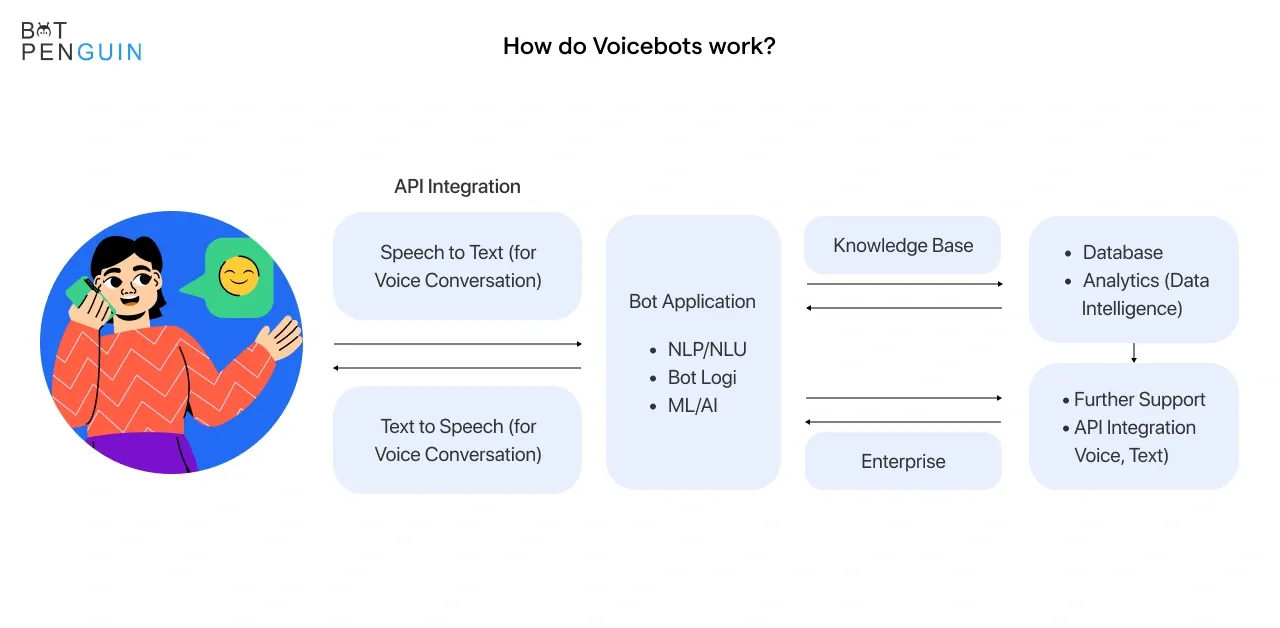
Voicebots function similarly to text chatbots. Although voicebots need a different phase for speech recognition than chatbots do.
The process is:
Step 1: A microphone device, such as a mobile phone or computer, is used to record the user's voice input.
Step 2: This data is transmitted to the cloud so that it can decode and determine the user's purpose.
Step 3: After transforming the audio message into text, the consumers' demands are examined using natural language processing models.
Step 4: The AI-based systems find the best responses or courses of action and produce a response.
Step 5: The user receives the answer as converted audio.
Why is a voice bot important now?
Here are a few reasons why voicebots are important:
- Voicebots provide a uniform and inclusive customer experience with the correct automation and AI.
- Voicebots offer a more effective, organic user interface.
- A voice bot will always be able to help consumers, regardless of the language they use, the time they talk, or where they are located. It guarantees that each client receives the same caliber of service.
- Voice bot helps businesses lower the cost of running their call centers and make their products more user-friendly.
- Voice bot connects the dots and leverages consumer data to give customized and one-of-a-kind replies, enhancing the CX, with the appropriate connections.
- The need for voicebots rises as more people utilize mobile devices: Voice apps are simple to utilize on mobile devices. Google, Apple, Microsoft, and Amazon, promote the best voice bot in the market.
- To provide a simpler, faster, and more dependable customer experience, the voicebots’ ultimate goal is to immediately solve customers' annoyances.
- Voice bot improves customer satisfaction by reducing wait times and scaling up to meet demand.
- As the demand for chatbots and speech bots rises, the market size according to IBM, companies spend $1.3 trillion annually on 265 billion customer support calls. Voice bots can help automate some of the process.
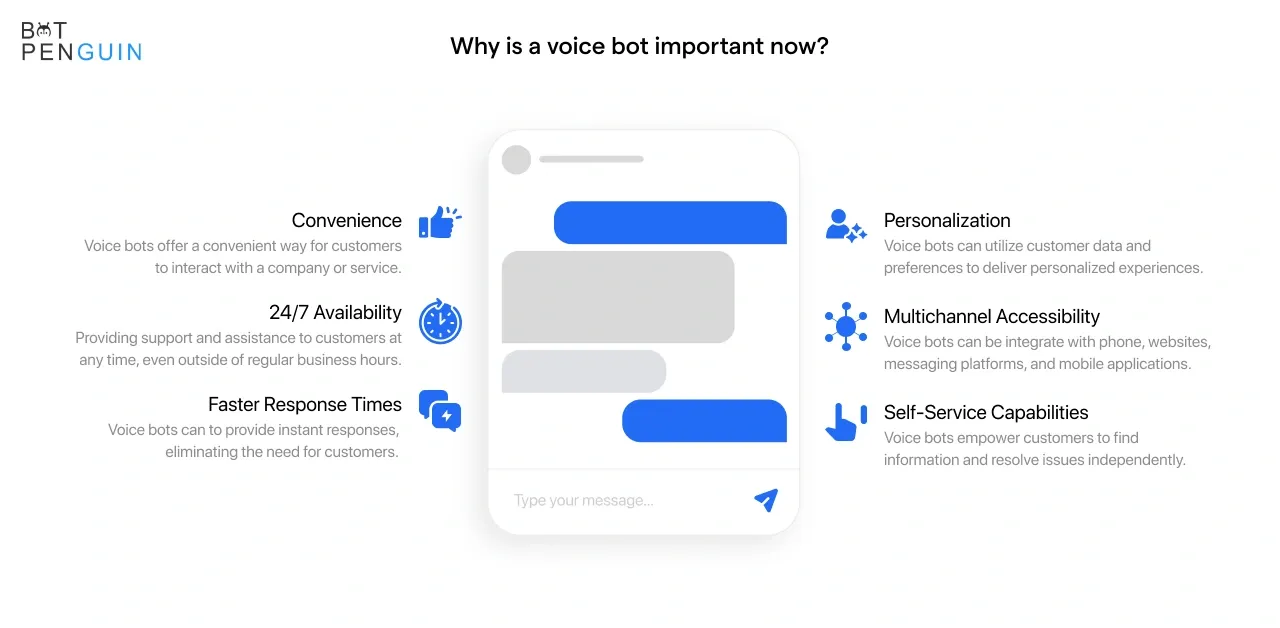
Why choose voicebots over chatbots?
If you are confused between voicebots and chatbots, then here are four key reasons for why Voicebots are favored over chatbots.
- Speaking rather than typing is a quicker approach to describing a problem. Typing takes longer to describe an issue than talking, especially for elderly persons.
- PWC research demonstrates that in terms of simplicity of use and speed of communication, voicebots are more beneficial for both younger and older persons.
- When communicating their difficulties, people tend to prefer human-like interactions and that's what a voice bot does.
- Advancements in both speech recognition and natural language understanding technology pushed voicebots into the mainstream line.
How to choose a voice bot technology provider?
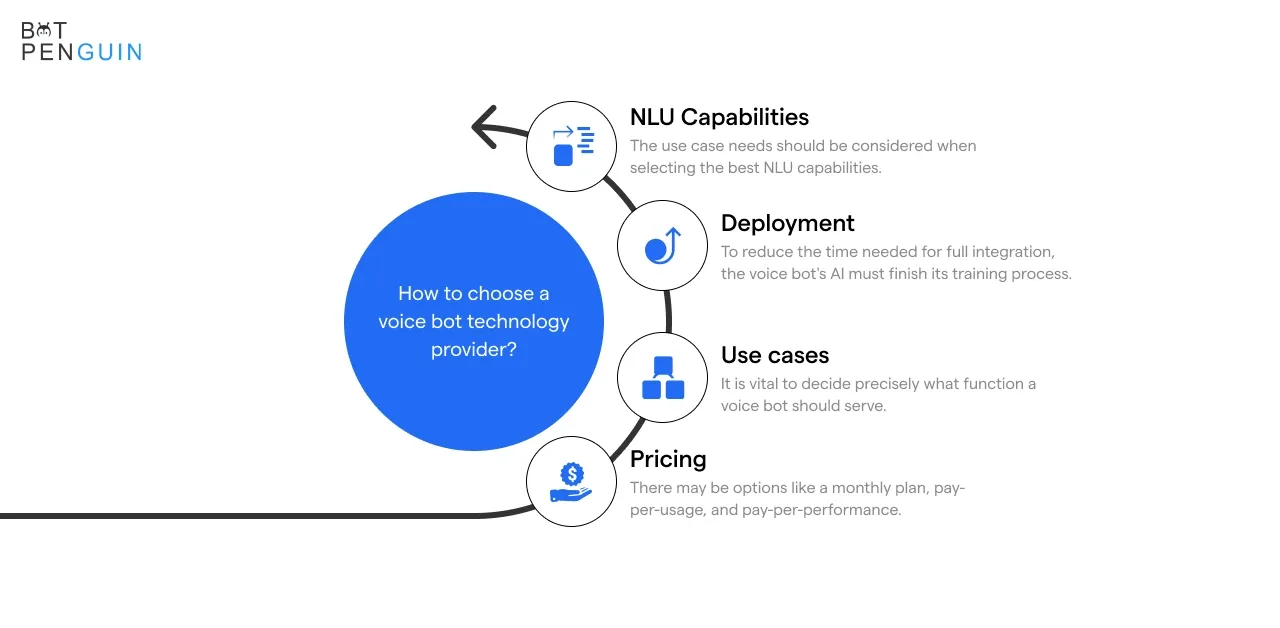
You can choose a voice bot with the help of these four important pointers:
NLU capabilities
The capabilities of a voice bot are constrained by the NLU architecture. The use case needs should be considered when selecting the best NLU capabilities.
Deployment
To reduce the time needed for full integration, the voice bot's AI must finish its training process. Installing the voice bot into the system without proper training might lead to security issues and user happiness. An AI that has been trained can speed up deployment.
Use cases
It is vital to decide precisely what function a voice bot should serve. Errors are more likely when several tasks are given to the same speech bot. Therefore, picking an application-specific bot would be more appropriate.
Pricing
Like chatbots, voice bots use a variety of payment methods. There may be options like a monthly plan, pay-per-usage, and pay-per-performance. At this stage, a payment schedule should be chosen taking into account how frequently the boat will be utilized.
Top 10 Voicebots that make technology more inclusive
Time to set your patience at a halt and dive straight into the top 10 list of voicebots that make technology more inclusive.
1. AI Rudder
AI Rudder permits human-AI communication in any language and for any reason. Businesses can automate their calling procedures at a cheaper cost through this voice chatbot. To ensure the clients' data security, AI Rudder has a specific data-protection module to hide important data during integration.
Additional security measures including SIP-level phone number rotation are also available. The key to success in SaaS is giving customers the most valuable, game-changing product possible.
2. Cocohub
To build conversational voicebots for video platforms like Zoom, Google Meet, and Facetime, you can use Cocohub. It can be made quickly and easily without any coding experience. You can have a voice bot that converses in human language. There is no need for buttons, IVRs, or any other constrictive alternatives.
Cocohub also allows users to personalize the avatar and customize how they want to. You can build your brand ambassador, personal assistant, or team member to meet people with the help of this voice bot. It also provides numerous one-click connections with websites, social media, messaging services, and online meeting tools.
3. VOIQ
The well-known voice bot platform VOIQ helps make technology more accessible. It allows companies to develop voice-based products that meet a variety of user demands thanks to several strong features. Regardless of technical proficiency, voice bot development is facilitated by VOIQ's user-friendly interface. Their voicebots ensure precise and contextual interactions by combining machine learning and natural language processing.
Due to voicebots' multilingual features, it is possible to communicate with others throughout the world in a variety of languages. As part of its dedication to accessibility, VOIQ offers voicebots that work on various hardware and software. VOIQ is an intriguing example of how voicebots may advance inclusion and improve the user experience.
4. RedRoute
RedRoute is a voice bot that responds to and handles customer requests just like one of your call center agents would. It interfaces with your phone system and customer management system to provide updates to customers and respond to their inquiries. The call is smoothly transferred to the call center personnel if RedRoute cannot help. The existing solution is excellent for businesses in the transportation and eCommerce industries. RedRoute, however, constantly adds new features to its repertoire.
5. Mindsay
By utilizing conversational automation, Mindsay voicebots offer straightforward and effective client engagement. Voicebots assist customer support teams with overcoming typical obstacles, enabling them to automate client requests. The best voice bot feature is to eliminate time-consuming procedures and maximize the usage of their workforce.
Mindsay voicebots assist businesses in the following ways:
- Developing their customer service automation strategy,
- Enabling maximum automation of customer interactions
- The low total cost of ownership from straightforward FAQs to intricate transactions.
6. Vozy
To support customer-centric businesses with automation, Vozy developed AI voicebots. This updated how businesses interacted with their consumers, that is, through voicebots and conversational artificial intelligence. Vozy offers businesses considerable cost savings and unmatched customer experiences with voicebots.
Vozy is a voice bot and conversational AI that boosts productivity through effective automation. To satisfy the growing need for omnichannel customer support, Vozy offers customized solutions.
7. Cognigy
In terms of conversational AI automation for contact centers, Cognigy has established itself as one of the best voice bot companies. Using a voice chatbot, you can use Cognigy.AI's low-code platform to automate staff and customer engagements. This voice bot facilitates communication through every channel, including phone, SMS, and mobile applications, in any language.
Cognigy.AI voicebots offer improved user experiences and benefits businesses by:
- Lowering support costs
- Enhancing scalability
- Superior user experiences
- Smoothly incorporated into backend systems
- Accurate, trustworthy intent recognition
- Highly adaptable dialogs
- Both SaaS and on-premises settings are compatible with Cognigy.AI voicebots.
8. Hatcher
Hatcher is an artificial intelligence voice bot that helps eCommerce companies manage their sales by improving customer engagement and experience. It helps in creating a voice bot and chatbot for your online business. Through their voicebots, your clients may explore and even purchase your items. Customers may ask their voicebots inquiries and make purchases. They also receive order updates.
By organizing all of your correspondence into one thread, one can develop a personal connection with each client. With the help of Hatcher voicebots customers can get tailored updates, deals, and suggestions. This will keep consumers entertained by automated AI voicebots.
9. Rep
Rep by Voicefront was the first company to generate branded artificial intelligence sales agents for e-commerce. Voicefront is developing a deep learning prediction system to quickly identify customers needing assistance and provide them with hyper-contextual, tailored artificial intelligence purchasing support. Rep AI provides tailored purchasing experiences for everyone by fusing conversational AI from ChatGPT with behavioral AI (built-in).
Rep will continuously scan the website to make sure it is always current. All inquiries concerning products will receive conversational responses from Rep voicebots. Even idioms and other terminology may be understood by their voice chatbot. It includes interactions in many languages, contextual assistance, and a 24/7 AI.
10. Wluper
Wluper is a pioneering voice bot platform that contributes to technological inclusion. Wluper's state-of-the-art technology makes it possible to develop voice-based solutions that meet various user demands. Wluper ensures that interactions are precise and contextually aware thanks to its sophisticated natural language processing and machine learning algorithms.
The platform's inclusive philosophy also includes the availability of numerous languages, enabling users from all backgrounds to interact easily. To ensure that people of all abilities may use Wluper's voice bot capabilities, it is clear that the company is committed to accessibility. Wluper is a prime example of how voicebots may transform technology and produce more equal experiences for all users by prioritizing inclusion.
Conclusion
In today's rapidly evolving technological landscape, voicebots play a crucial role in making technology more inclusive and accessible. By removing the barriers of physical interaction, these intelligent voice assistants are bridging the gap for individuals with various abilities and preferences.
As we've seen, the top 10 voicebots mentioned in this blog are just the tip of the iceberg in showcasing the potential of this continually growing field. In conclusion, voicebot technology has undoubtedly proven itself as a vital component in the future of seamless, personalized, and inclusive user experiences.
Embracing these advancements will not only revolutionize the way we communicate with technology, but also ensure equitable access to information and services for all.
Frequently Asked Questions
How do voicebots contribute to inclusivity in technology?
Voicebots contribute to inclusivity by providing voice-based interfaces that enable individuals with disabilities, language barriers, or limited dexterity to interact with technology effortlessly. They offer alternative means of communication and access to information, making technology more accessible and inclusive for a wider range of users.
What are the benefits of using inclusive voicebots?
Using inclusive voicebots offers benefits such as hands-free operation, natural language processing, personalized experiences, and improved accessibility for individuals with disabilities. They enhance convenience, productivity, and user experience, enabling a more inclusive and user-friendly technology environment.
How can voicebots assist individuals with disabilities?
Voicebots assist individuals with disabilities by allowing them to perform tasks using voice commands, eliminating the need for manual interaction. They can help with daily activities, such as controlling smart devices, setting reminders, reading text aloud, and providing information, empowering individuals with disabilities to navigate technology independently.
How can voicebots enhance the inclusivity of smart homes?
Voicebots play a crucial role in making smart homes more inclusive by enabling users to control various devices and services using voice commands. This accessibility feature allows individuals with disabilities or mobility challenges to independently manage their living environment, enhancing their overall quality of life.
Do voicebots support multiple languages, benefiting diverse populations?
Yes, many voicebots support multiple languages, making them valuable for diverse populations. By understanding and responding to different languages, these voicebots cater to users from various linguistic backgrounds, fostering inclusivity and ensuring equal access to technology-driven services and information.


